Feline Leukemia Virus (FeLV)
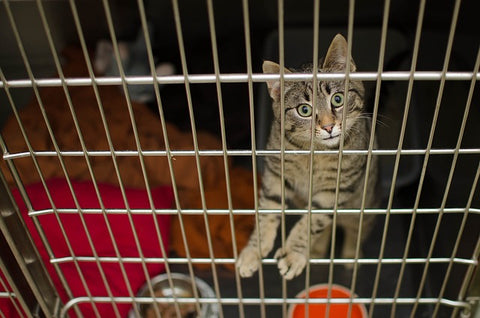
Are you thinking of adopting a FeLV-positive cat? Or perhaps a cat you already love has just been diagnosed with this disease.
Whatever brought you to this post, I’m sure you have many questions about feline leukemia virus (FeLV). It’s my goal to answer them all here.
I’ll start with explaining what the FeLV virus is, how it behaves inside your cat, what the prognosis is for a cat with FeLV, and what treatments are currently available.
But before diving in, there are four things you should know upfront about feline leukemia virus:
- FeLV is one of the most common infectious diseases in cats, so this is not a problem your vet is going to be unfamiliar with.
- FeLV is not contagious to humans or other non-cat pets, likes dogs.
- FeLV diagnosis is not a death sentence. In fact, many cats get over this disease.
- Cats with FeLV can live long, fulfilling lives, especially with top-notch care from a loving guardian.
What is feline leukemia virus (FeLV)?

Feline leukemia virus, which we’ll call by its acronym, FeLV, is one of the most common infectious diseases in cats. It was once extremely widespread, but thanks to the development of vaccines and testing over the last 25 years, only 2-3% of all cats in the United States and Canada are affected today.[1]
FeLV is a retrovirus. A retrovirus is a kind of virus that inserts itself into the DNA of its host, literally changing the infected animal’s genome.
Retroviruses belong in a family of viruses known as oncoviruses. Oncoviruses cause the development of cancers, as well as other diseases.[2] FeLV, specifically, can cause lymphoma, which is cancer involving a certain type of white blood cell, and leukemia, which is a cancer of the bone marrow, as well as other types of tumors.
There are actually at least four different strains of FeLV that we know of. They go by letter names: A, B, C, and T. Some of the types are more likely to cause a cat to get anemia, in which the body produces too-few red blood cells, while other types are more likely to suppress a cat’s immune system.[3]
What does the FeLV virus do to a cat’s body?
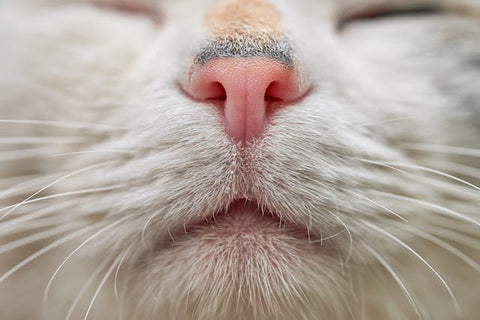
The FeLV usually enters the cat’s body through the nose and throat and begins replicating in the tonsils. Some cats are able to eliminate the virus from their bodies at this stage.
If the cat cannot clear the virus from its body, it will spread to the lymph tissues, intestines, bladder, and salivary glands.[4]
If the virus is able to move on to the bone marrow, the cat will likely be infected for life.
The bone marrow is where blood cells are manufactured. White blood cells containing FeLV will begin circulating in the bloodstream.
These white bloods will be compromised by the virus, so they’ll be unable to fight off ordinary infections. Mutations in these cells, caused by the virus, can also lead to cancer.[5]
How does a cat get infected with FeLV?
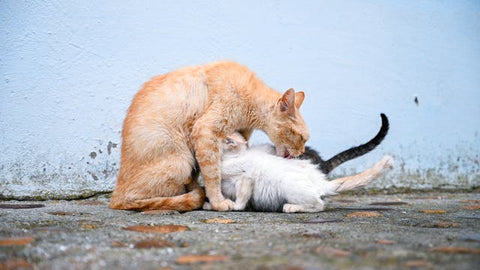
Cats who are ill with FeLV shed the virus in their saliva, blood, nasal secretions, feces, urine, and, in the case of nursing mother cats, in their milk.
The most common way for a cat to contract FeLV is from the saliva of a sick cat, often through bite wounds.
But any close, prolonged contact between cats can spread FeLV. Sharing food and water dishes and litter boxes, as well as mutual grooming, could spread this disease.
Infected mother cats can spread FeLV to their kittens while they are pregnant with them, or after, while nursing.
What kinds of cats are at greatest risk of contracting FeLV?

Some cats are at higher risk than other cats for getting FeLV.
Cats who live outdoors, even only some of the time, are at risk of getting bitten by an FeLV-positive cat.
Kittens born to infected mother cats are also at greater risk, due to their immune systems. In fact, the older a cat gets, the less likely he is to contract FeLV.
Cats who live with infected cats are, obviously, also at greater risk of getting FeLV themselves.
Interestingly, FeLV is not considered to be a particularly contagious virus. It doesn’t survive very long outside of a cat’s body (a few hours, at most), and it’s easily destroyed with soap and water.[6] FeLV actually requires a prolonged period of contact between cats for it to spread.[7]
What happens when a cat is infected with FeLV?
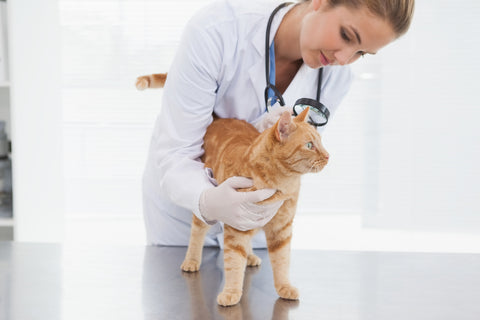
When a cat contracts FeLV, it can affect a cat in three different ways. These infection types are called abortive, regressive, and progressive.[8]
Abortive FeLV infection
An abortive infection is the best-case scenario. The infected cat’s immune system attacks the virus before it can insert itself into the cat’s genome. Cats with abortive infections may never show any signs of being ill, and they may never even test positive for the disease.
But cats who have had abortive infections will have antibodies against FeLV and will be immune to future infections.
At least 20-30% of all cats exposed to FeLV develop abortive infections. Recent studies suggest that the percentage may be even higher.[9]
Regressive FeLV infection
In a regressive infection a cat’s body is able to “contain” the virus. The FeLV virus does become incorporated into the DNA, but the cat’s own immune system prevents the virus from replicating, and keeps it out of the bloodstream.
In a regressive infection there are usually no viral particles in the cat’s blood after the initial infection. Cats with regressive infections won’t show signs of disease and they won’t be able to infect other cats.
However, if a cat with a regressive infection becomes immunocompromised for any reason – another illness, or because of a medication – the virus can start replicating again. A cat with a regressive infection could become sick and would then be capable of infecting another cat.
About 30-40% of cats who are infected with FeLV experience a regressive infection.
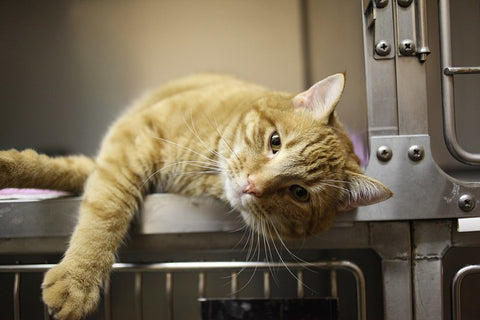
Progressive FeLV infection
Cats with a progressive FeLV infection are at the highest risk of developing an FeLV-associated disease. Although cats may show no signs of being sick for years, eventually, FeLV-related diseases, such as anemia or cancer will develop – typically within two to three years.
In a progressive infection, a cat’s bone marrow becomes infected, allowing the virus to replicate and spread. A cat with a progressive FeLV infection can also infect other cats.
About 30-40% of FeLV cases are progressive, and kittens are at higher risk of developing the progressive form of this disease.
How do veterinarians test for FeLV?

Testing for FeLV is a little complicated. There can be false negatives, meaning that the test shows a cat is disease-free, when she really isn’t, and false-positives that show that a cat who doesn’t really have the disease, does. Even true-positive tests don’t really tell the whole story.
Cats typically need to be tested more than once, or with more than one type of test, to be sure, especially if the cat’s exposure to this disease was recent. This has less to do with the accuracy of the tests than the fact that FeLV is kind of a wily disease.
There are basically three different kinds of tests your vet can give a cat to see if he has FeLV.
The ELISA test
ELISA stands for enzyme-linked immunosorbent assay. An ELISA test is a quick test that can be done in a veterinarian’s office. This test can find FeLV particles in the bloodstream.
If an ELISA test is negative, it doesn’t necessarily mean that the cat is not infected with FeLV. There just might not be enough viral particles in the blood yet, if the infection was recent. If a cat was exposed to FeLV, and the first ELISA test comes back negative, a vet may suggest retesting again in a month, possibly with another test type.
Cats with regressive infections may also get false-negative results on an ELISA test if the fluctuating level of virus in the blood is momentarily very low.
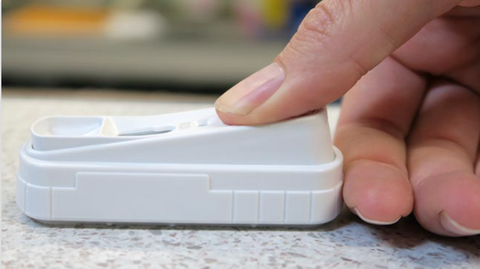
If an ELISA test is positive, a cat should still be retested. Abortive infections can show up positive at first, but then quickly turn negative. A second test might be recommended in eight to 12 weeks, to help differentiate between a short-term, temporary infection, and a more persistent infection.
In other words, an ELISA test, by itself, provides some information, but is not conclusive.
The IFA test
IFA stands for indirect immunofluorescent antibody assay. An IFA tests for viral proteins, called antigens.[10]
If your cat tested positive for FeLV on an ELISA test, your vet may recommend sending your cat’s sample out to a lab for an IFA test.
An IFA test can tell if the virus is replicating. If this test is positive, a cat has an active infection. This could mean that the cat is in the early stages of a regressive infection, or in the midst of a progressive infection. The only way to know which one it is, is with ANOTHER follow-up test.
If the second follow-up test is positive weeks or months after the first, the cat, unfortunately, has a progressive infection.
If the second follow-up test, is negative, then the cat has a regressive infection, and the virus is no longer replicating.
The PCR test
PCR stands for polymerase chain reaction. A PCR test checks for the genetic material of the virus, and can tell if the virus has integrated itself into a cat’s genome.
Cats with abortive infections will have negative results on a PCR test, which is good news (even though “negative” does not always sound like good news).
Cats with regressive and progressive infections will have positive results on a PCR, meaning that the virus’ genetic material was found in the cat’s DNA.
A positive FeLV test is not a death sentence
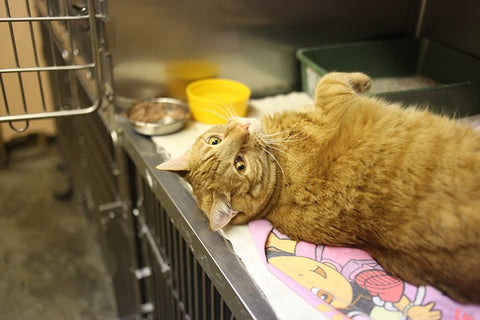
The main takeaway from all this test talk is that an initial positive test result is not a diagnosis of FeLV.
A positive test is also not a sign that a cat should be euthanized. Unless a cat is ill and suffering beyond what veterinary science can offer to help, an FeLV-positive test does not mean a cat should be put to sleep.
A positive FeLV test should not be a death sentence[11]
What are the signs and symptoms of FeLV?
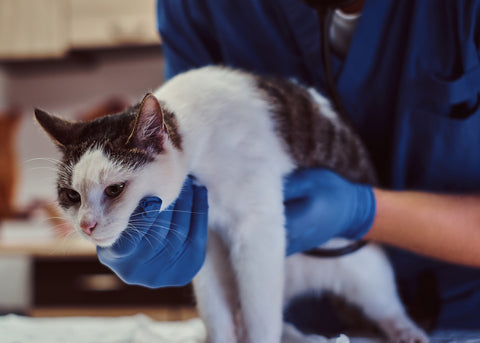
One of the problems with FeLV is that there are so many potential symptoms that it’s easy to mistake this disease for any number of other diseases. In fact, the American Association of Feline Practitioners recommends that any cat showing signs of illness should be tested for FeLV, because there are so many health issues that are associated with this virus.
FeLV can cause cancers, blood disorders, and immune deficiencies that allow common bacteria, viruses, protozoa, and fungi to flourish. Having no signs of disease at all is also common, especially in early-stage infection.
But over time, in regressive and progressive infections, a cat will go through cycles of health and sickness.
Some of the clinical symptoms a cat may experience include:
- A loss of appetite
- Weight loss
- Poor coat condition
- Enlarged lymph nodes
- Persistent fever
- Pale gums and other mucus membranes
- Inflammation of gums and mouth
- Infections of skin, bladder, upper respiratory system
- Diarrhea
- Seizures, behavior changes, neurological disorders
- Eye conditions
- Abortion of kittens or other reproductive problems[12]
Some of the other health conditions that the FeLV virus can cause include:
- Leukemia – cancer of the white blood cells
- Lymphoma – cancer of the lymphoid cells[13]
- Infertility[14]
How can you prevent your cat from getting FeLV?
The only way to ensure your cat never gets FeLV, is to prevent exposure to the cats carrying the disease in the first place. Here's how:
Keep cats indoors
Keep your cats indoors, and if your cat is allowed supervised outdoor access, like a catio, make sure the enclosure is secure.
(Read this blog post on indoor versus outdoor living for cats for more information.)
Test any new cats
Any cats entering your home, as fosters or as new adoptees, should be tested for FeLV.
Spay and neuter
Spay and neuter your cats. Neutering minimizes biting, as intact male cats no longer have the desire to fight over mates. Spaying puts an end to the tragedy of this disease being passed from a mother cat to her kittens.
(Read about spaying and neutering in this post.)
Is there a vaccine for FeLV?
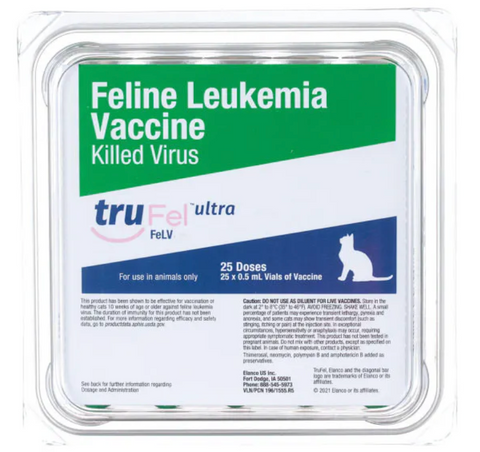
There is a vaccine -- in fact, there are several different types of FeLV vaccines, but none of them are 100% effective. Cats at risk of exposure, such as those that go outdoors, should definitely be vaccinated, but it is not a magic bullet against FeLV.
If your cat is currently uninfected, discuss the advantages and disadvantages of vaccination with your veterinarian.
There will be an initial course of two injections, at eight weeks, if your cat is still a kitten, and then again at 11-12 weeks, with yearly boosters. For cats at low risk of becoming infected, the American Association of Feline Practioners’ recommends revaccination every two years.[15]
If you do vaccinate your cat for FeLV, you will still have to do everything you can to prevent exposure to the disease.
If your cat is already positive for FeLV, vaccination will not help and will put an extra strain on her immune system.[16]
Note that the FeLV vaccine will not cause false-positive results on any FeLV test, including ELISA, IFA, and PCR.
What can I do to help my FeLV-positive cat?

The guardian of an FeLV-positive cat will have to be extra vigilant with his or her cat’s health. You’ll have to carefully monitor your cat’s weight, appetite, activity level, behavior, pooping and peeing habits, and the appearance of your cat’s mouth and eyes, to head any potential health problems off at the pass.
Any illness, no matter how seemingly minor, can be a threat to a cat with a compromised immune system.
Treat infections and problems as they arise
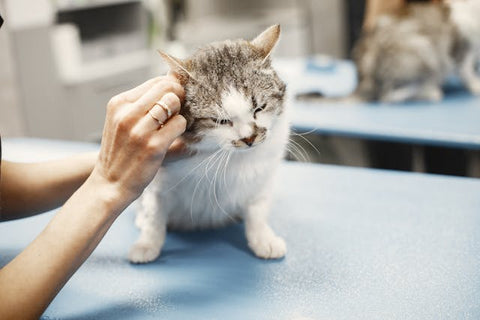
Your vet can treat any secondary infections or disease as they come. For example, cats with bacterial infections can get antibiotics. Cats with anemia can get blood transfusions. Cats who have a poor appetite can get appetite stimulants. Cats with fever can get anti-inflammatories.
With supportive care, a cat can enjoy a good quality of life, health, and even longevity. Some cats can live free of FeLV-associated diseases for their entire lives.
Other things you can do to ensure that your FeLV-positive cat is as healthy as can be for as long as possible include:
- Minimizing stress. Avoid changes to your cat’s life and routine, if you can. Read this post on how cat’s handle change, for more information.
- Keeping your cat indoors. Not only will you help prevent further spread of FeLV, but you’ll protect your FeLV-positive cat from other infectious diseases.
- Providing the best, most nutritional cat food you can afford.
- Taking your cat to the vet more often, at least twice a year,[17] and as soon as any issues crop up. FeLV compromises a cat’s immune system, meaning she will be more susceptible to ordinary infections.
Stay up to date on the latest FeLV news, in case new treatments become available.
Can feline leukemia virus be cured?
There is no known cure for FeLV.
What is the prognosis for a cat with FeLV?
Cats who contract FeLV can live fulfilling, happy, and normal cat lives for years, often without any ill effects from the disease.
The median survival time for an FeLV-positive cat after diagnosis is 2.5 years, but cats with regressive disease will likely live longer than that.[18]
Should I adopt a cat who is FeLV-positive?
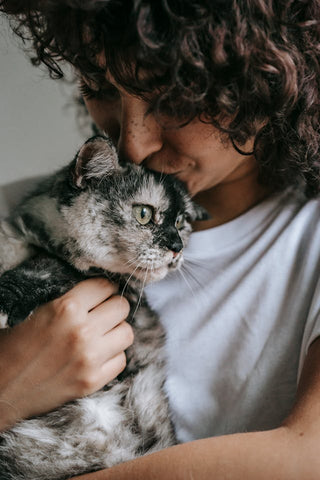
The world has not always been good to cats. FeLV-positive cats fare worse than most.
Historically, cats with this disease were euthanized as soon as they were diagnosed. Even today, in shelters all over the U.S., a positive FeLV test is a death sentence. A 2022 survey of 139 animal shelters revealed that 43% routinely euthanize cats who test positive for FeLV.[19]
Even in shelters that do not euthanize FeLV-positive cats, adoption rates for these cats are low. This is unfortunate, because loving an FeLV-positive cat can be extremely rewarding.
As long as you don’t have other cats in your home, you are willing to keep your cat indoors, and you can cover the cost of regular vet visits, you have everything an FeLV-positive cat needs.
What treatments are currently available for FeLV?
Even though there is currently no cure for FeLV, scientists are always working on new treatments.
These new treatments currently include immune modulators, such as human interferon alpha, or feline recombinant interferon omega.[20] These drugs seem to lower mortality rates in FeLV-positive cats.[21]
The USDA has also approved the use of a treatment for feline immunodeficiency virus (FIV) in FeLV called Lymphocyte T-Cell Immunomodulator (LTCI).
Raltegravir and azidothymidine (AZT), drugs used to treat HIV infections in humans, seem to reduce replication of FeLV.[22][23]
And this is far from an exhaustive list. Be hopeful.
Love Pinterest? Here's a Pinterest-friendly pin for your boards!

Dawn LaFontaine
Dawn LaFontaine is a lifelong animal lover who always seems to have a little pet hair in her keyboard. Her blog, Kitty Contemplations, helps cat guardians better understand and care for the special beings they share their lives and homes with. Her cat-products business, Cat in the Box, sells beautiful, well-made, and award-winning products that she designed to meet the biological needs of cats.
_______________
FOOTNOTES
[1] “Feline Leukemia Virus.” Cornell University College of Veterinary Medicine, 31 Jan. 2024, www.vet.cornell.edu/departments/cornell-feline-health-center/health-information/feline-health-topics/feline-leukemia-virus.
[2] Feline Leukaemia Virus FeLV. International Cat Care, 6 Oct. 2019, icatcare.org/advice/feline-leukaemia-virus-felv/.
[3] ibid.
[4] Denis, Kelly A. St. “Feline Leukemia Virus Disease - Generalized Conditions.” Merck Veterinary Manual, Merck Veterinary Manual, 12 Feb. 2024, www.merckvetmanual.com/generalized-conditions/feline-leukemia-virus/feline-leukemia-virus-disease.
[5] “Feline Leukemia Virus (FeLV).” PetMD, www.petmd.com/cat/conditions/infectious-parasitic/feline-leukemia-virus-felv. Accessed 19 Feb. 2024.
[6] “Feline Leukemia Virus (FeLV).” Alley Cat Allies, 3 Dec. 2021, www.alleycat.org/resources/feline-leukemia-virus-felv/.
[7] “Feline Leukemia Virus Disease Complex: VCA Animal Hospital: VCA Animal Hospitals.” Vca, vcahospitals.com/know-your-pet/feline-leukemia-virus-disease-complex. Accessed 19 Feb. 2024.
[8] “Feline Leukemia Virus.” Cornell University College of Veterinary Medicine.
[9] Little, Susan, et al. “2020 AAFP Feline Retrovirus Testing and Management Guidelines.” Journal of Feline Medicine and Surgery, American Association of Feline Practitioners, 2020. https://journals.sagepub.com/doi/pdf/10.1177/1098612X19895940
[10] Feline Leukaemia Virus FeLV. International Cat Care.
[11] “Feline Leukemia Virus (FeLV).” Alley Cat Allies.
[12] “Feline Leukemia Virus.” Cornell University College of Veterinary Medicine.
[13] “Feline Leukemia Virus Disease Complex: VCA Animal Hospital.
[14] “Feline Leukemia Virus (FeLV).” Alley Cat Allies.
[15] Little, Susan, et al. “2020 AAFP Feline Retrovirus Testing and Management Guidelines.” Journal of Feline Medicine and Surgery.
[16] “Feline Leukemia Virus (FeLV).” PetMD.
[17] Little, Susan, et al. “2020 AAFP Feline Retrovirus Testing and Management Guidelines.” Journal of Feline Medicine and Surgery.
[18] “Feline Leukemia Virus.” Cornell University College of Veterinary Medicine.
[19] Dezubiria P, Amirian ES, Spera K, Crawford PC, Levy JK. Animal shelter management of feline leukemia virus and feline immunodeficiency virus infections in cats. Front Vet Sci. 2023 Jan 18;9:1003388. doi: 10.3389/fvets.2022.1003388. PMID: 36744227; PMCID: PMC9890067. https://www.ncbi.nlm.nih.gov/pmc/articles/PMC9890067/
[20] “Feline Leukemia Virus Disease Complex: VCA Animal Hospital.
[21] “Feline Leukemia Virus.” Wikipedia, Wikimedia Foundation, 28 Dec. 2023, en.wikipedia.org/wiki/Feline_leukemia_virus.
[22] Feline Leukaemia Virus FeLV. International Cat Care.
[23] Little, Susan, et al. “2020 AAFP Feline Retrovirus Testing and Management Guidelines.” Journal of Feline Medicine and Surgery.

